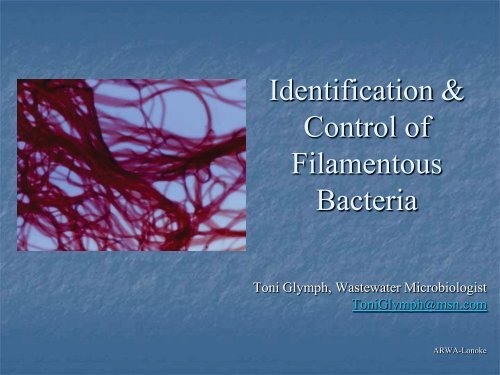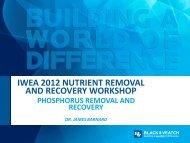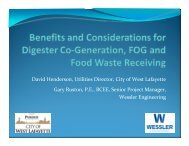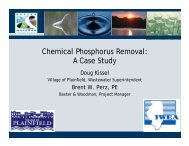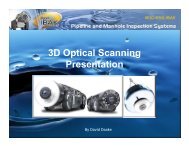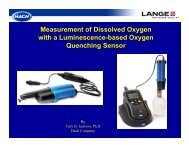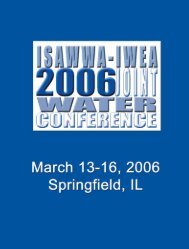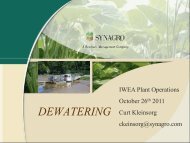Identification and Control of Filamentous Bacteria
Identification and Control of Filamentous Bacteria
Identification and Control of Filamentous Bacteria
You also want an ePaper? Increase the reach of your titles
YUMPU automatically turns print PDFs into web optimized ePapers that Google loves.
<strong>Identification</strong> &<br />
<strong>Control</strong> <strong>of</strong><br />
<strong>Filamentous</strong><br />
<strong>Bacteria</strong><br />
Toni Glymph, Wastewater Microbiologist<br />
ToniGlymph@msn.com<br />
ARWA-Lonoke
<strong>Filamentous</strong> <strong>Bacteria</strong><br />
Sludge Bulking
<strong>Filamentous</strong> <strong>Bacteria</strong><br />
Sludge Foaming
FILAMENTOUS BACTERIA<br />
� In the activated sludge treatment system,<br />
bacteria may occur singly, or in small<br />
chains or clumps.<br />
� Shifts in the activated sludge environment<br />
such as changes in pH, dissolved oxygen,<br />
nutrients etc. will <strong>of</strong>ten cause a change in<br />
the behavior <strong>of</strong> the bacteria.
FILAMENTOUS BACTERIA<br />
� In stead <strong>of</strong> single<br />
cells, small chains or<br />
clumps, the bacteria<br />
will begin to form<br />
longer “chains” which<br />
develop into<br />
filamentous bacteria.
<strong>Filamentous</strong> <strong>Bacteria</strong><br />
� Round bacteria will<br />
form a chain with<br />
other round<br />
bacteria, square<br />
with square,<br />
rectangle with<br />
rectangle etc.
(round)<br />
FILAMENTOUS BACTERIA<br />
Cocci<br />
(oval)<br />
(discoid)<br />
(rod-shaped) (square)<br />
Bacillus<br />
(rectangle)
Typical Observation<br />
� Filament Shape<br />
� Filament Size<br />
� Cell shape<br />
� Cell size<br />
� Cell Septa<br />
� Indentations<br />
� Sheath<br />
(present/absent)<br />
� Branching<br />
(true/false)<br />
� Epiphyte (attached<br />
growth)<br />
� Motility
Straight<br />
Typical Observation:<br />
Filament Shape<br />
Smoothly<br />
Curved<br />
Irregular
Typical Observation:<br />
Filament width<br />
Filament Size<br />
Filament length
Typical Observation:<br />
Cell Shape
Typical Observation:<br />
Cell Size<br />
Length <strong>of</strong> cell<br />
Width <strong>of</strong> cell
Cell septa with<br />
no indentation<br />
Typical Observation:<br />
Cell Septa<br />
Cell septa with<br />
indentation<br />
Cell septa not<br />
clearly seen
Typical Observation:<br />
Sheath<br />
Sheath<br />
Individual cells within a sheath
True branching<br />
Fungus<br />
Typical Observation:<br />
Branching<br />
False<br />
branching<br />
S. natans
Typical Observation:<br />
Epiphyte (Attached Growth)
Typical Observation:<br />
Motility
Microscope Requirements<br />
� Phase contrast Microscope<br />
� 10X or 20 X objective<br />
� 40 X objective<br />
� 100 X (oil immersion lens)
� Gram Stain<br />
� Neisser Stain<br />
Stains
Gram Stain<br />
� Separates bacteria into two categories<br />
� Determined by the bacteria cell wall<br />
� Gram (+) bacteria cell wall retains the<br />
purple color<br />
� Gram ( - ) bacteria cell wall loses the<br />
purple color<br />
� Gram positive bacteria are purple<br />
� Gram negative bacteria are pink
Gram positive<br />
Polysaccharide<br />
“Slime Layer”<br />
Cell Wall<br />
Cell Membrane<br />
Gram Stain<br />
Gram negative<br />
Lipopolysaccharide<br />
“Slime Layer”<br />
Phospholipid<br />
Lipoprotein<br />
Cell Wall<br />
Cell Membrane
Gram Stain<br />
Gram (+) Nocardia sp. Gram (-) Type 1701
Gram variable Type 0041<br />
Gram Stain
Neisser Stain<br />
� Separates bacteria into two<br />
categories<br />
� Distinguishes the bacteria which<br />
contain granules that accumulate<br />
polyphosphate<br />
� Neisser (+) bluish color<br />
� Neisser ( - ) brownish color
Neisser Stain<br />
Neisser (+)<br />
Nostocoida limicola<br />
Neisser (+)<br />
granules
Neisser (+) Type 0092<br />
Neisser Stain<br />
Neisser (+) Nostocoida limicola<br />
<strong>and</strong> Neisser (-) Thiothrix
Slide Preparation<br />
� Wet Mount<br />
� Smear<br />
� Dried for staining
Slide Preparation:<br />
Wet Mount<br />
� A drop <strong>of</strong> a well mixed<br />
representative sample is place on a<br />
clean grease-free slide.<br />
� A clean cover-glass is placed on top.<br />
Avoid entrapment <strong>of</strong> air as much as<br />
possible.<br />
� The size <strong>of</strong> the drop is critical<br />
� Use a pipette with a small opening
Slide<br />
Slide Preparation:<br />
Wet Mount<br />
Drop<br />
Cover glass
Slide Preparation:<br />
Wet Mount<br />
� This allows the observer to view<br />
the microorganisms live in their<br />
environment.<br />
� With a live sample, measurements<br />
can be taken <strong>and</strong> cell shape <strong>and</strong><br />
size can be accurately determined.
Slide Preparation:<br />
Smear<br />
� Place a drop <strong>of</strong> sample on a clean,<br />
wax-free slide <strong>and</strong> smear across<br />
the slide.<br />
� Let the slide air dry. DO NOT<br />
HEAT FIX!
Slide<br />
Slide Preparation:<br />
Smear
Sample Collection<br />
� For bulking sludge, collect<br />
samples from the discharge end <strong>of</strong><br />
the aeration basin.<br />
� For foaming sludge, collect a<br />
sample <strong>of</strong> the foam.
<strong>Filamentous</strong> <strong>Bacteria</strong><br />
� Most filamentous bacteria in<br />
Activated Sludge are associated<br />
with low F/M along with some<br />
other factor(s) that uniquely gives<br />
them an advantage over the other<br />
microorganisms.<br />
� Discovering <strong>and</strong> changing what<br />
gives them the advantage will<br />
help control their dominance.
<strong>Filamentous</strong> <strong>Bacteria</strong><br />
A Simpler Approach<br />
� Bulking Filaments<br />
� Foaming Filaments
<strong>Filamentous</strong> <strong>Bacteria</strong><br />
Bulking Filaments<br />
� Collect a sample <strong>of</strong> the mixed<br />
liquor from the discharge end <strong>of</strong><br />
the aeration basin<br />
� Make a smear<br />
� Gram stain<br />
� Neisser stain (optional)<br />
� Wet Mount
<strong>Filamentous</strong> <strong>Bacteria</strong><br />
A Simpler Approach<br />
� Nostocoida limicola<br />
� Sphaerotilus natans<br />
� Haliscomenobacter<br />
Hydrossis<br />
� Thiothrix I & II<br />
� Microthrix parvicella<br />
� Nocardia<br />
� Beggiatoa<br />
� Type 0041<br />
� Type 0675<br />
� Type 0092<br />
� Type 1851<br />
� Type 1701<br />
� Type 021N<br />
� Type 0914<br />
� Type 0961<br />
� Type 1863
Gram (+)<br />
(purple)<br />
Nostocoida limicola<br />
Microthrix parvicella<br />
<strong>Filamentous</strong> <strong>Bacteria</strong><br />
Bulking Filaments<br />
Gram Stain<br />
Gram<br />
Variable<br />
Type 0041<br />
Type 0675<br />
Type 1851<br />
Gram (-)<br />
(pink)<br />
Investigate<br />
further
Gram (+)<br />
(purple)<br />
Nostocoida limicola<br />
Microthrix parvicella<br />
<strong>Filamentous</strong> <strong>Bacteria</strong><br />
Bulking Filaments<br />
Gram Stain<br />
Gram<br />
Variable<br />
Type 0041<br />
Type 0675<br />
Type 1851<br />
Gram (-)<br />
(pink)<br />
Investigate<br />
further
Bulking Filaments<br />
Nostocoida limicola
Bulking Filaments<br />
Nostocoida limicola
Bulking Filaments<br />
Nostocoida limicola<br />
� This filament is associated with<br />
� Low F:M<br />
� Starch containing wastes (potato<br />
processing)<br />
� More commonly found in industrial<br />
waste plants
Bulking Filaments<br />
Microthrix parvicella
Bulking Filaments<br />
Microthrix parvicella<br />
� This filament is associated with<br />
� Low F:M<br />
� Animal <strong>and</strong> vegetable greases, oils<br />
<strong>and</strong> fats<br />
� More common in colder<br />
temperatures<br />
� Also causes foaming
<strong>Filamentous</strong> <strong>Bacteria</strong><br />
� Nostocoida limicola<br />
� Sphaerotilus natans<br />
� Haliscomenobacter<br />
Hydrossis<br />
� Thiothrix I & II<br />
� Microthrix parvicella<br />
� Beggiatoa<br />
Bulking Filaments<br />
� Type 0041<br />
� Type 0675<br />
� Type 0092<br />
� Type 1851<br />
� Type 1701<br />
� Type 021N<br />
� Type 0914<br />
� Type 0961
Gram (+)<br />
(purple)<br />
Nostocoida limicola<br />
Microthrix parvicella<br />
Bulking Filaments<br />
Gram Stain<br />
Gram<br />
Variable<br />
Type 0041<br />
Type 0675<br />
Type 1851<br />
Gram (-)<br />
(pink)<br />
Investigate<br />
further
Bulking Filaments<br />
� Type 0041<br />
� Type 0675<br />
� Type 1851<br />
Gram Variable
Gram Variable<br />
Type 0041
Gram Variable<br />
Type 0041<br />
� This filament is associated with<br />
� Low F:M<br />
� Nutrient deficient conditions
Gram Variable<br />
Type 0675
Gram Variable<br />
Type 0675<br />
� This filament is associated with<br />
� Low F:M<br />
� Nutrient deficient conditions
Gram Variable<br />
Type 1851
Gram Variable<br />
Type 1851
Gram Variable<br />
Type 1851 Bundles
� Type 0041<br />
� Type 0675<br />
� Type 1851<br />
Gram Variable<br />
� All three are Gram Variable<br />
� All three are favored under the<br />
same conditions<br />
� Low F/M <strong>and</strong> Low nutrients
<strong>Filamentous</strong> <strong>Bacteria</strong><br />
� Nostocoida limicola<br />
� Sphaerotilus natans<br />
� Haliscomenobacter<br />
Hydrossis<br />
� Thiothrix I & II<br />
� Microthrix parvicella<br />
� Beggiatoa<br />
Bulking Filaments<br />
� Type 0041<br />
� Type 0675<br />
� Type 0092<br />
� Type 1851<br />
� Type 1701<br />
� Type 021N<br />
� Type 0914<br />
� Type 0961
Gram (+)<br />
(purple)<br />
Nostocoida limicola<br />
Bulking Filaments<br />
Gram Stain<br />
Gram<br />
Variable<br />
Type 0041<br />
Type 0675<br />
Type 1851<br />
Gram (-)<br />
(pink)<br />
Investigate<br />
further
Neisser (+)<br />
(bluish)<br />
Nostocoida limicola<br />
Type 0092<br />
Bulking Filaments<br />
Neisser Stain<br />
Neisser (-)<br />
(brownish)<br />
All others
Neisser (+)<br />
(bluish)<br />
Nostocoida limicola *<br />
Type 0092<br />
Bulking Filaments<br />
Neisser Stain<br />
Neisser (-)<br />
(brownish)<br />
All others
<strong>Filamentous</strong> <strong>Bacteria</strong><br />
� Nostocoida limicola<br />
� Sphaerotilus natans<br />
� Haliscomenobacter<br />
Hydrossis<br />
� Thiothrix I & II<br />
� Microthrix parvicella<br />
� Beggiatoa<br />
Bulking Filaments<br />
� Type 0041<br />
� Type 0675<br />
� Type 0092<br />
� Type 1851<br />
� Type 1701<br />
� Type 021N<br />
� Type 0914<br />
� Type 0961
Neisser Positive<br />
Nostocoida Limicola
Neisser Positive<br />
Type 0092
Neisser Positive<br />
Type 0092<br />
� This filament is associated with<br />
� Low F:M<br />
� Excess oils <strong>and</strong> grease<br />
� Colder temperatures
<strong>Filamentous</strong> <strong>Bacteria</strong><br />
� Nostocoida limicola<br />
� Sphaerotilus natans<br />
� Haliscomenobacter<br />
Hydrossis<br />
� Thiothrix I & II<br />
� Microthrix parvicella<br />
� Beggiatoa<br />
Bulking Filaments<br />
� Type 0041<br />
� Type 0675<br />
� Type 0092<br />
� Type 1851<br />
� Type 1701<br />
� Type 021N<br />
� Type 0914<br />
� Type 0961
Neisser (+)<br />
(bluish)<br />
Nostocoida limicola<br />
Type 0092<br />
Bulking Filaments<br />
Neisser Stain<br />
Neisser (-)<br />
(brownish)<br />
All others
Bulking Filaments<br />
Other Characteristics<br />
� Sheath<br />
� Epiphyte (Attached growth)<br />
� Sulfur granules<br />
� Motility
Bulking Filaments<br />
� Sheath w/Epiphyte<br />
� Type 1701<br />
� Type 0041<br />
� Type 0675<br />
� Type 1851<br />
Sheath<br />
� Sheath w/o Epiphyte<br />
� Sphaerotilus natans<br />
� Thiothrix I & II<br />
� Haliscomenobacter<br />
hydrossis
Bulking Filaments<br />
Sheath<br />
� Sheath w/Epiphyte ( Attached Growth)<br />
� Type 1701<br />
� Type 0041*<br />
� Type 0675*<br />
� Type 1851*
<strong>Filamentous</strong> <strong>Bacteria</strong><br />
� Nostocoida limicola<br />
� Sphaerotilus natans<br />
� Haliscomenobacter<br />
Hydrossis<br />
� Thiothrix I & II<br />
� Microthrix parvicella<br />
� Beggiatoa<br />
Bulking Filaments<br />
� Type 0041<br />
� Type 0675<br />
� Type 0092<br />
� Type 1851<br />
� Type 1701<br />
� Type 021N<br />
� Type 0914<br />
� Type 0961
Sheath w/Epiphyte<br />
Type 0041
Sheath w/Epiphyte<br />
Type 0675
Sheath w/Epiphyte<br />
Type 1851
Sheath w/Epiphyte<br />
Type 1701
Type 1701
Sheath w/Epiphyte<br />
Type 1701<br />
� This filament is associated with<br />
low DO conditions
<strong>Filamentous</strong> <strong>Bacteria</strong><br />
� Nostocoida limicola<br />
� Sphaerotilus natans<br />
� Haliscomenobacter<br />
Hydrossis<br />
� Thiothrix I & II<br />
� Microthrix parvicella<br />
� Beggiatoa<br />
Bulking Filaments<br />
� Type 0041<br />
� Type 0675<br />
� Type 0092<br />
� Type 1851<br />
� Type 1701<br />
� Type 021N<br />
� Type 0914<br />
� Type 0961
Sheath w/o Epiphyte<br />
� Sheath w/o Epiphyte (Attached growth)<br />
� Sphaerotilus natans<br />
� Thiothrix I & II<br />
� Haliscomenobacter hydrossis
Sheath w/o Epiphyte<br />
Sphaerotilus natans
Sheath w/o Epiphyte<br />
Sphaerotilus natans
Sheath w/o Epiphyte<br />
Sphaerotilus natans<br />
� S. natan also exhibits false branching<br />
� Associated with conditions where there is<br />
inadequate DO for the applied organic<br />
loading
Type I<br />
Sheath w/o Epiphyte<br />
Thiothrix I & II<br />
Type II
Sheath w/o Epiphyte<br />
Thiothrix I & II<br />
� This filament is associated with<br />
� The presence <strong>of</strong> reduced sulfur<br />
compounds (septic wastes)<br />
� Wastes deficient in nitrogen<br />
� The presence <strong>of</strong> organic acids
Sheath w/o Epiphyte<br />
H. Hydrossis
Sheath w/o Epiphyte<br />
H. Hydrossis<br />
� This filament is associated with<br />
low DO conditions
<strong>Filamentous</strong> <strong>Bacteria</strong><br />
� Nostocoida limicola<br />
� Sphaerotilus natans<br />
� Haliscomenobacter<br />
Hydrossis<br />
� Thiothrix I & II<br />
� Microthrix parvicella<br />
� Beggiatoa<br />
Bulking Filaments<br />
� Type 0041<br />
� Type 0675<br />
� Type 0092<br />
� Type 1851<br />
� Type 1701<br />
� Type 021N<br />
� Type 0914<br />
� Type 0961
Bulking Filaments<br />
� Type 021N<br />
Sulfur Granules<br />
� Thiothrix I & II*<br />
� Type 0914<br />
� Beggiatoa
Sulfur Granules<br />
Thiothrix I
Sulfur Granules<br />
Thiothrix I
Sulfur Granules<br />
Thiothrix II
Bulking Filaments<br />
Sulfur Granules<br />
� These filaments are all associated<br />
with<br />
� The presence <strong>of</strong> reduced sulfur<br />
compounds (septic wastes)<br />
� Wastes deficient in nitrogen<br />
� The presence <strong>of</strong> organic acids
Sulfur Granules<br />
Type 021N
Sulfur Granules<br />
Type 021N<br />
Stacked (hockey puck)<br />
cells
Sulfur Granules<br />
Type 0914
Sulfur Granules<br />
Beggiatoa
<strong>Filamentous</strong> <strong>Bacteria</strong><br />
� Nostocoida limicola<br />
� Sphaerotilus natans<br />
� Haliscomenobacter<br />
Hydrossis<br />
� Thiothrix I & II<br />
� Microthrix parvicella<br />
� Beggiatoa<br />
Bulking Filaments<br />
� Type 0041<br />
� Type 0675<br />
� Type 0092<br />
� Type 1851<br />
� Type 1701<br />
� Type 021N<br />
� Type 0914<br />
� Type 0961
Bulking Filaments<br />
� Beggiatoa*<br />
Motility
Bulking Filaments<br />
Motility<br />
� Beggiatoa is the only filament that<br />
is motile<br />
� The presence <strong>of</strong> this filament is<br />
associated with<br />
� Organic overloading<br />
� Septic conditions<br />
� Most <strong>of</strong>ten found in trickling filters<br />
<strong>and</strong> RBCs
Bulking Filaments<br />
Beggiatoa
<strong>Filamentous</strong> <strong>Bacteria</strong><br />
� Nostocoida limicola<br />
� Sphaerotilus natans<br />
� Haliscomenobacter<br />
Hydrossis<br />
� Thiothrix I & II<br />
� Microthrix parvicella<br />
� Beggiatoa<br />
Bulking Filaments<br />
� Type 0041<br />
� Type 0675<br />
� Type 0092<br />
� Type 1851<br />
� Type 1701<br />
� Type 021N<br />
� Type 0914<br />
� Type 0961
Bulking Filaments<br />
� Not Gram +<br />
Type 0961<br />
� Not Neisser +<br />
� No sheath<br />
� No attached growth<br />
� No sulfur granules<br />
� Not motile
Bulking Filaments<br />
Type 0961
Bulking Filaments<br />
Type 0961
� Low F:M<br />
Bulking Filaments<br />
Type 0961<br />
� Low soluble BOD
<strong>Filamentous</strong> <strong>Bacteria</strong><br />
Foaming Filaments<br />
� All foaming filaments are<br />
associated with:<br />
� Excess greases, oils <strong>and</strong> fats<br />
� Low F:M<br />
� Hydrophobic cell walls
<strong>Filamentous</strong> <strong>Bacteria</strong><br />
Foaming Filaments<br />
� Collect a sample <strong>of</strong> the foam<br />
� Make a smear<br />
� Gram stain
� Type 1863<br />
<strong>Filamentous</strong> <strong>Bacteria</strong><br />
Foaming Filaments<br />
� Microthrix parvicella<br />
� Nocardia
<strong>Filamentous</strong> <strong>Bacteria</strong><br />
Foaming Filaments<br />
Gram (+)<br />
(purple)<br />
Microthrix parvicella<br />
Nocardia<br />
Gram Stain<br />
Gram (-)<br />
(pink)<br />
Type 1863
<strong>Filamentous</strong> <strong>Bacteria</strong><br />
Foaming Filaments<br />
Gram (+)<br />
(purple)<br />
Microthrix parvicella<br />
Nocardia<br />
Gram Stain<br />
Gram (-)<br />
(pink)<br />
Type 1863
Foaming Filaments Type<br />
1863
Foaming Filaments Type<br />
1863
Foaming Filaments Type<br />
1863<br />
� Type 1863 is associated with<br />
� Excess grease <strong>and</strong> fat<br />
� Low F:M<br />
� Decline in aeration basin pH
� Type 1863<br />
<strong>Filamentous</strong> <strong>Bacteria</strong><br />
Foaming Filaments<br />
� Microthrix parvicella<br />
� Nocardia
<strong>Filamentous</strong> <strong>Bacteria</strong><br />
Foaming Filaments<br />
Gram (+)<br />
(purple)<br />
Microthrix parvicella<br />
Nocardia<br />
Gram Stain<br />
Gram (-)<br />
(pink)<br />
Type 1863
<strong>Filamentous</strong> <strong>Bacteria</strong><br />
Microthrix parvicella
<strong>Filamentous</strong> <strong>Bacteria</strong><br />
Microthrix parvicella
<strong>Filamentous</strong> <strong>Bacteria</strong><br />
Microthrix parvicella<br />
� Microthrix parvicella is associated<br />
with<br />
� Animal <strong>and</strong> vegetable greases <strong>and</strong><br />
fats<br />
� Low F:M<br />
� Colder temperatures
<strong>Filamentous</strong> <strong>Bacteria</strong><br />
Nocardia
<strong>Filamentous</strong> <strong>Bacteria</strong><br />
Nocardia<br />
� This filament is strongly<br />
associated with<br />
� Long MCRTs (sludge age)<br />
� Greases, oils, fats, petroleum, rubber<br />
� Warmer temperatures
<strong>Filamentous</strong> <strong>Bacteria</strong><br />
About Nocardia<br />
No foaming<br />
Very little foaming<br />
Foaming
Foaming<br />
Less foaming<br />
<strong>Filamentous</strong> <strong>Bacteria</strong><br />
About Nocardia<br />
No foaming
Nocardia<br />
Early Stage Nocardia
Nocardia<br />
Early Stage Nocardia
Nocardia<br />
Mid - Stage Nocardia
Nocardia<br />
Mid - Stage Nocardia
Nocardia<br />
Late Stage Nocardia
Nocardia<br />
Late Stage Nocardia
Nocardia<br />
Adult Stage Nocardia
� Type 1863<br />
<strong>Filamentous</strong> <strong>Bacteria</strong><br />
Foaming Filaments<br />
� Microthrix parvicella<br />
� Nocardia
Neisser (+)<br />
(bluish)<br />
Nostocoida limicola<br />
Type 0092<br />
Foaming Filaments<br />
Neisser Stain<br />
Neisser (+)<br />
Granules<br />
Microthrix<br />
Nocardia<br />
Neisser (-)<br />
(brownish)<br />
All others
Neisser Positive Granules<br />
Microthrix
Neisser Positive Granules<br />
Nocardia
Filament <strong>Control</strong><br />
� For low F:M or low food<br />
� Add more food or get rid <strong>of</strong> some bugs<br />
� For low DO<br />
� Add more oxygen
Filament <strong>Control</strong><br />
� Excess greases, oils <strong>and</strong> fats<br />
� Grease control<br />
� For a long MCRT or Sludge age<br />
� Shorten it<br />
� Sulfur granules<br />
� Pre-aeration, add oxygen
Most Important<br />
� Keep a process chart <strong>of</strong> treatment<br />
system parameters<br />
� Measure the parameters routinely<br />
<strong>and</strong> consistently<br />
� Measure the parameters when the<br />
treatment system is working<br />
properly


